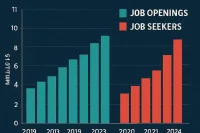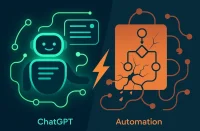Beat the ATS? They Lied — the resume truth revealed
Beat the ATS advice has become one of the biggest myths in job searching, costing countless candidates opportunities and interviews. An ex-Google recruiter who screened over 100,000 resumes at Google, Uber, and TikTok reveals the shocking truth: most ATS advice is completely wrong. The problem isn’t rejection by some mysterious algorithm—it’s invisibility. When you apply for a job and hear nothing back, it’s not because the ATS filtered you out; it’s because no human ever opened your application.
What ATS systems actually are
The database reality, not the AI myth
Contrary to popular belief, ATS stands for “Applicant Tracking System,” not “Applicant Terminator System.” These aren’t AI-powered robots scanning resumes with red glowing eyes. They’re simply databases that store files, let recruiters post jobs to job boards, track candidates through the interview process, and help search through applications. Saying you want to beat the ATS is like saying you want to beat Excel.
How ATS parsing really works
When you apply for a job and upload your resume, the ATS parses for contact information to build and populate a profile. It’s not auto-rejecting or auto-filtering by keywords. The system stores resumes and helps recruiters manage applications—that’s it. There’s no hidden rejection algorithm scanning your resume for a checklist or operating on a scoring system.
The five biggest ATS myths debunked
Myth #1: ATS automatically rejects resumes without keywords
The myth suggests that if you don’t include specific keywords like “cross-functional” or “stakeholder alignment,” the ATS tosses your resume into the trash. This is completely wrong. There’s no hidden rejection algorithm scanning your resume for a checklist. The ATS doesn’t ding you for missing words and doesn’t operate on a scoring system. In fact, it doesn’t reject candidates at all.
Myth #2: You need an ATS-compliant resume
Resume scoring tools claim to tell you how ATS-compliant your resume is, assigning percentages like 67%, 82%, or 93%. These scores aren’t based on anything real—they’re not coming from an ATS at all. They’re created by third-party companies like JobScan trying to sell resume audits. These tools invented a metric, attached it to your resume, and framed it as a barrier so they can sell you their solution.
Myth #3: The white font trick works
This persistent myth suggests hiding job description keywords in white font at the bottom of your resume so the ATS will scan them but human recruiters won’t see them. This doesn’t work and makes you look like you’re trying to game the system. When your resume goes into the ATS, everything including white font gets extracted into plain text, and if a recruiter copies and pastes your resume, that hidden section shows up in full.
Myth #4: ATS systems use AI to screen candidates
There’s a persistent belief that modern ATS platforms use AI to automatically evaluate and reject candidates. This is not how hiring works. Most ATS platforms are old legacy systems that are 20-30 years old, basically patched together with duct tape. They were built to track, not to judge. Legally, companies aren’t allowed to use AI in that way without running into serious compliance issues.
Myth #5: Getting rejected means the system filtered you out
When you apply and hear nothing back, you assume the ATS rejected you with some hidden algorithm. This belief is one of the biggest distractions in the entire job search process. Federal rules like OFCCP and EEOC explicitly prohibit using automated tools to make hiring decisions. Every resume is supposed to be reviewed by human eyes—that’s not optional, it’s required by law.
What recruiters actually see in ATS systems
The human reality behind the screen
Recruiters see a simple list of applicants, usually organized by date of application. They’re not using complex AI algorithms or scoring systems. Most recruiters don’t use keyword filters because they’re clunky, outdated, and often surface the wrong candidates entirely. The real challenge is volume—hundreds of thousands of people apply to jobs every day, and recruiters are skimming resumes in real time under pressure.
Why most resumes never get noticed
The problem isn’t rejection—it’s invisibility. Recruiters are juggling multiple roles, hundreds of resumes, and tight deadlines. If your resume opens with a dense block of text or generic job duties, you’ve already made their job harder. The resumes that get noticed are scannable and instantly clear, leading with impact rather than burying the good stuff.
What actually works for resume success
Write for the reader, not the system
Successful candidates write for humans, not algorithms. They make their most recent job title immediately obvious, frontload their best accomplishments, and use layouts that work on any screen. They show business impact, not job activity, highlighting outcomes with specific numbers like “reduced churn by 14%” or “cut onboarding time by 3 weeks.”
Bridge the title gap before disqualification
If your current title doesn’t match the role you’re applying for, even with perfect experience, you may get skipped. Add context using parentheses and clarifiers, like “Product Manager (Functionally leading roadmap without formal title).” If recruiters can’t see your fit within a few seconds, they won’t keep reading.
Optimize for attention, not software
Make your value clear in the first few lines by leading with results. Use formatting that supports quick scanning, not keyword stuffing. Your resume isn’t being judged by a system—it’s being skimmed by a human. Humans don’t respond to scores; they respond to clarity.
The real problem: Volume and visibility
Why silence isn’t judgment
That silence you experience after applying isn’t judgment—it’s proof that no human even opened your application. Even if ATS filtering existed, it wouldn’t solve your actual problem because the real issue is volume. Hundreds of thousands of people apply to jobs every day, and even if you optimize your resume perfectly for some imaginary score, you’re just landing in a bigger pile of other people who did the same thing.
Knockout questions vs. ATS filtering
Some people do get rejected within seconds, but it’s not because the ATS is using automation to reject them. Instead, companies may ask knockout questions like “Are you over 18?” or “Do you require visa sponsorship?” These questions are set up by recruiters to filter people out at the very beginning, but that’s not the core function of ATS systems.
The clarity framework that actually works
Stop optimizing for filters that don’t exist
Instead of asking “Did I get enough keywords?” start asking “Does this make sense to a human if they’re skimming it in 5 seconds?” The recruiter isn’t your enemy, and the ATS isn’t your gatekeeper. Your real challenge is simple: get seen, get read, and get remembered. That starts with clarity.
Clarity Wins, Not Keywords
Recruiters don’t remember endless buzzwords—they remember clarity. Make your job postings simple, human, and memorable. Post your job on WhatJobs and connect with candidates who value substance over noise.
Post a Job Free for 30 Days →Focus on what makes you hirable
Don’t optimize for density—optimize for clarity. Use the job title and core skills from the posting and embed them naturally into your achievements and bullet points. Don’t just say “project management.” Instead, say “led a cross-functional team of eight, delivering new product features 2 weeks ahead of schedule.” You’re not trying to game a system; you’re trying to stop a human from scrolling.
Why the ATS industry perpetuates these myths
Third-party companies profiting from confusion
Companies like JobScan have created fake metrics and attached them to resumes, framing them as barriers so they can sell solutions. Once you believe that score matters, you stop writing your resume for people and start rewriting it for some fake algorithm, which ends up watering down your strengths. No one on the hiring team will ever see that number.
The real cost of chasing fake scores
Optimizing your resume for a fake score doesn’t just waste your time—it makes your resume worse. You start removing the parts that make you credible, all in the name of chasing a number that never mattered. You don’t need a higher score; you need a clearer message.
Federal regulations and legal requirements
OFCCP and EEOC compliance requirements
Federal rules explicitly prohibit using automated tools to make hiring decisions. Every resume is supposed to be reviewed by human eyes—that’s not optional, it’s required by law. This makes the idea of AI or bots rejecting you before anyone reads your resume not just wrong, but impossible.
Why companies can’t use AI for hiring decisions
Legally, companies aren’t allowed to use AI for hiring decisions without running into serious compliance issues. There are currently lawsuits against platforms suspected of doing exactly that. The risk is too high, the systems aren’t that smart, and recruiters aren’t outsourcing judgment to an algorithm.
How to write a reader-compliant resume
Clean layout and standard formatting
There’s no such thing as an ATS-compliant resume. What you need is a reader-compliant resume—something a human can skim in 5 seconds and immediately understand why you’re qualified. Use clean layouts, stick to standard fonts, avoid templates with graphics or gimmicks, and make sure your strongest achievements show up where the eye lands first.
Lead with impact, not activities
If your bullet points sound like a job description (“managed weekly standups” or “oversaw internal comms”), you’re describing job duties. What recruiters want to see is momentum and impact—what changed because you were there? Highlight outcomes with specific numbers that tell a story and move the reader forward.
The bottom line: Stop solving the wrong problem
From guessing to targeting
If you’ve been wondering why your applications go silent, why you’re not hearing back, or what’s wrong with your resume, it’s not because of some hidden algorithm. It’s because you were solving the wrong problem. Now that you know how these systems actually work, you can stop optimizing for filters that don’t exist and start focusing on what does: writing a resume that makes your value from a business perspective clear to the people who make the decisions.
Give yourself a real shot at interviews
When you stop guessing and start targeting the right things, you’re not just tweaking your resume—you’re giving yourself a real shot at landing interviews for the jobs you actually want. The algorithm isn’t some secret system scoring your application. The algorithm is the recruiter. The algorithm is the hiring manager—the actual humans viewing your resume.
FAQs
Q: Is it really possible to beat the ATS?
A: No, because ATS systems don’t reject candidates—they’re databases that store resumes and help recruiters manage applications. The real challenge is getting noticed by humans, not beating algorithms.
Q: Why do beat the ATS tools show percentage scores?
A: These scores are fake metrics created by third-party companies like JobScan to sell resume audits. They’re not based on real ATS functionality and no hiring team will ever see these numbers.
Q: What’s the biggest myth about beat the ATS strategies?
A: The biggest myth is that ATS systems use AI to automatically reject candidates. Most ATS platforms are 20-30 year old legacy systems built to track, not judge, and federal law prohibits automated hiring decisions.
Q: How can I actually improve my resume if beat the ATS advice is wrong?
A: Focus on clarity for human readers: lead with impact, use specific numbers, bridge title gaps with context, and make your value immediately clear in the first few lines.
Live example — user point of view
I spent months trying to optimize my resume for ATS scores, stuffing keywords and using every “beat the ATS” trick I found online. I was getting 80%+ scores on JobScan but still not hearing back from employers. Then I learned the truth—those scores were meaningless. I completely rewrote my resume focusing on clarity and impact, leading with specific results like “increased sales by 23%” instead of keyword stuffing. Within two weeks, I had three interview requests. The problem was never the ATS; it was that my resume wasn’t clear enough for humans to quickly understand my value.




